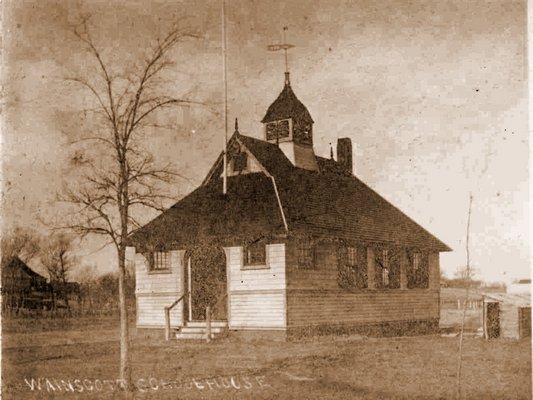
When Leon and Leesa Wagner bought their property at 802 Town Line Road in Sagaponack in 2013, they weren’t aware that their purchase included a historic structure.
Last year, they commissioned the Bridgehampton-based architectural firm Oza/Sabbeth Architecture to design a roughly 12,000-square-foot, modern two-story home on the parcel. After submitting plans, they were asked by Sagaponack Village officials to keep and restore one of the existing structures so that it will look the way it did in its heyday in the late 1800s and early 1900s.
That structure is the now-dilapidated former Wainscott School, the third schoolhouse used to educate students in that school district’s long history.
Speaking on behalf of his clients in a recent interview, architect Nilay Oza said the Wagners were receptive to the village’s request, and more than willing to honor it.
“They loved that structure and initially did not necessarily know the prominence of it. Very quickly, we all learned that it was a fairly important structure for Wainscott,” Mr. Oza explained. “Obviously, their desire was to renovate it to the closest approximation … of what the schoolhouse looked like.”
With some research, and only a single black-and-white photograph for reference, Mr. Oza and his partner, Peter Sabbeth, were able to develop a sketch that re-creates the facade of the roughly 1,000-square-foot, one-story building, complete with an elevated belfry and a flagpole just above an alcove that leads to the foyer.
“Sometimes we all had to look at the photograph that exists ... and in some sense collaboratively look at, ‘OK, this is the height of the belfry. There appear to be some alcoves that exist,’” Mr. Oza said.
Sketching the renovation plan was very much an involved task, the architect said. He explained that visits to the property were necessary as well, as “it would be really awkward to try and build a structure from a photograph.” And even though the old schoolhouse is in poor condition, he said the exterior—which consists primarily of white shingled siding—showed plenty enough detail to work with. Access to the interior, however, was not possible, as the overgrown building is secured by a fence and the door and windows are boarded up.
According to “History of Wainscott School” by Mary S. Petrie, an unidentified newspaper had described the third schoolhouse as being built in Queen Anne style and designed by New York architect Henry M. Congdon. It operated as the Wainscott School, evidently on Main Street where the present school sits today, from 1884 to 1930, up until school officials felt that its amenities—a pot-bellied stove and chemical toilets—needed to be replaced with modern amenities
“So this schoolhouse too was moved away, bought by Charles Schwenk,” Ms. Petrie’s pamphlet says.
Ms. Petrie had described the interior of the schoolhouse as being filled with cherry and ash desks and seats and, in the foyer, “hooks for the hats and wraps of the school children.” It was also adorned with “two handsome chandeliers, pendant from the ceiling.”
The Wagners, however, intend to keep the structure mostly empty. “It’s just an open hall. Kind of like what the schoolhouse would have been in the past,” Mr. Oza said. “They have not fully come to terms with what it’s going to be used for.”
The plans for the schoolhouse have already been approved by the Sagaponack Village Zoning Board of Appeals and Planning Board, and the latter board had approved it with the condition that the Wagners do not have any landscaping planted in front of the schoolhouse so that it could be viewed publicly from the street. As it stands now, the structure is overgrown with trees and shrubs, blocking it from view.
The schoolhouse sketch is currently before the village’s Architectural and Historic Review Board and is pending approval. Mr. Oza said that because the Wagners want to make sure that the schoolhouse looks exactly as it once did, the couple is looking forward to working with the AHRB as a sounding board and hearing its members’ thoughts about the sketch.
Mr. Oza added that restoring such an old structure, from an architect’s standpoint, is a meticulous job. “You’re working against your designer’s instinct,” he said.
“It’s a really charming and graceful little structure. It’s been nice to sort of re-create something that’s both charming and sort of nice,” Mr. Oza added. “We don’t get to do structures like that in our professional, everyday life.